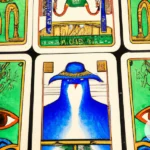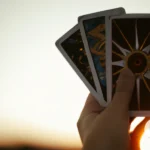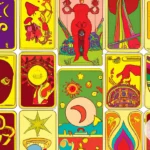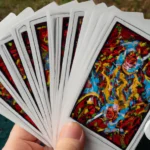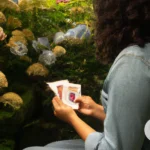Exploring the world of divination can leave one feeling mystified with a wide array of options to choose from. One of the most renowned methods of divination comes in the form of cards, with Tarot and Oracle cards being the most popular. While both sets of cards can be used to gain insight and address questions, they differ in their origins, structure, and use. With such diversity among the decks to choose from, it can be a daunting task to select the right one for your needs. In this article, we take a closer look at the differences and similarities between Tarot and Oracle cards, and examine the wide range of decks available within each category.
Tarot Cards
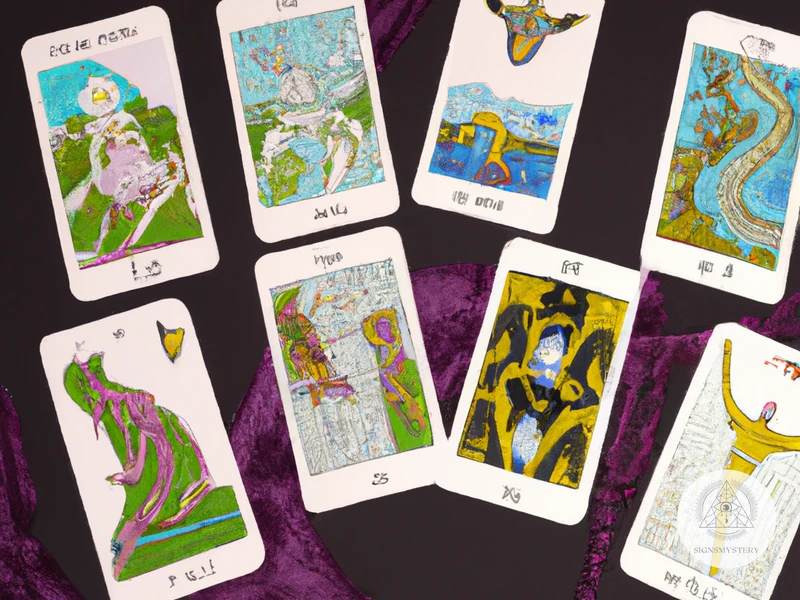
The world of tarot cards is mysterious and fascinating, with a long history and many different interpretations. It’s no wonder that they have captured the imagination of people for centuries. Understanding the structure, meaning, and diversity of tarot cards can be essential for anyone interested in learning about this complex system of divination. In this section of the article, we will explore the rich history, structure, meaning, and diversity of tarot cards, and how they differ from oracle cards. To delve deeper into the symbolism found in tarot cards, check out our article on tarot card symbolism.
History
Tarot cards are believed to have originated in Italy in the 14th century, but their exact origin is still uncertain. Some historians believe that they were used purely for entertainment, while others posit that their use was much more mystical and widespread. The earliest surviving tarot card decks date back to the 15th century and were used for divinatory purposes.
One of the most famous tarot decks is the Rider-Waite-Smith Tarot. Created in the early 20th century by Arthur Edward Waite and illustrated by Pamela Colman Smith, this deck is still widely used today and has become a standard for many tarot readers. It features 78 cards divided into two main groups: the Major Arcana and the Minor Arcana.
The Major Arcana is a group of 22 cards that are often considered the most important cards in the deck. They represent major life events, archetypes, and spiritual or philosophical concepts. Each Major Arcana card depicts a unique scene and is numbered with a Roman numeral.
The Minor Arcana consists of 56 cards divided into four suits: Wands, Cups, Swords, and Pentacles (Coins in some decks). Each suit has 10 numbered cards and four court cards, which depict people or archetypes. The meanings of each card can vary depending on the specific deck and the interpretation of the reader.
Oracle cards, on the other hand, have a much less clear origin. They are believed to have originated in Europe in the 18th or 19th century, but there is little historical evidence to support that claim. Oracle cards have been used for divination and spiritual purposes for centuries, but the practice has become more mainstream in recent years.
There are many different types of oracle cards, including angel cards, fairy cards, Goddess cards, and animal cards. Unlike tarot cards, oracle cards do not have a standardized structure or number of cards. The meanings of the cards, as well as the artwork, can vary widely depending on the deck.
In recent years, there has been a resurgence of interest in both tarot and oracle cards, and more and more people are turning to these tools for spiritual guidance and self-discovery. However, the debate between which type of card is better for divination purposes continues.
Some argue that tarot cards are more comprehensive and offer a deeper level of insight due to their standardized structure and rich symbolism, while others prefer the flexibility and personalization of oracle cards. Understanding the history and structure of each type of card can help individuals make informed decisions about which tool is best for their needs.
Structure
In terms of structure, both tarot cards and oracle cards are similar in that they are typically made up of a deck of cards with each card featuring a unique image and message. However, there are a few key differences between the two.
Tarot Cards:
– A standard tarot deck contains 78 cards, with 22 Major Arcana cards and 56 Minor Arcana cards.
– The Minor Arcana is divided into four suits: Cups, Swords, Wands, and Pentacles, and each suit has 14 cards (Ace to 10, plus four Court cards).
– The Major Arcana cards are not divided into suits, but rather represent archetypal figures and concepts.
– Each card has a specific number and name, along with an image that corresponds to its meaning.
The suits and court cards in tarot decks are often used to provide additional insight and detailed information in a reading. The suits represent different elements or areas of life, while the Court cards represent different personalities or roles.
Oracle Cards:
– The number of cards in an oracle deck can vary, but they usually have fewer cards than tarot decks.
– Unlike tarot decks, oracle cards do not have a set structure or format. Some oracle decks may have themes or categories for their cards, while others may feature a random assortment of images and messages.
– While some oracle cards may have numbers or names, they are not typically as important as the imagery on the card.
Unlike tarot cards, which have a set structure and specific meanings for each card, oracle cards are more open to interpretation and can be used in a variety of ways.
Numbers in tarot cards are often used to provide additional insight and meaning, as well as indicate the progression of a situation or journey. In oracle decks, the focus is more on the individual images and messages of each card, rather than on a set structure or numbering system.
While both tarot cards and oracle cards are similar in their use of a deck of cards with unique images and messages, they differ in their structure and format. Tarot cards have a set structure and meaning for each card, while oracle cards are more open to interpretation and can vary in their themes and categories.
Meaning and Use
Tarot cards and oracle cards are both used for divination, which is the practice of seeking insight or guidance from a higher power or the universe. The specific meanings and uses of each type of card deck can vary depending on the individual deck and its symbolism.
Tarot Cards
– The cards in a tarot deck are typically divided into two groups: the Major Arcana and the Minor Arcana.
– The Major Arcana cards represent major life events and themes, such as the Fool (representing new beginnings) and the Death card (symbolizing transformation).
– The Minor Arcana cards are divided into four suits (typically swords, cups, wands, and pentacles) and represent more specific aspects of life, such as relationships or career.
– Tarot cards are often used for gaining insight into a situation and for advice on how to proceed. They can also be used for meditation or reflection.
Oracle Cards
– Oracle cards typically have a more specific theme or focus than tarot cards, such as angels, fairies, or animal spirits.
– There is often no standardized structure or organization to an oracle deck, so the cards can vary greatly in meaning from deck to deck.
– Oracle cards are often used for seeking guidance or insight into a specific topic or question. They can also be used for inspiration or creative brainstorming.
Both tarot cards and oracle cards can be powerful tools for personal growth and spiritual development. The choice between using one or the other (or both) ultimately comes down to personal preference and which deck resonates with the individual. Some people may prefer the structure and tradition of tarot cards, while others may resonate more with the specific theme and imagery of an oracle deck.
Diversity of Tarot Cards Decks
There is an extensive variety of Tarot card decks available in the market. Each of these decks has a different artistic style and unique symbolism. Some popular examples of Tarot cards decks include:
- Rider-Waite Tarot Deck – The most commonly used Tarot deck, created in the early 20th century. This deck features rich symbolism and detailed illustrations.
- Thoth Tarot Deck – Designed by Aleister Crowley and illustrated by Lady Frieda Harris, this deck is known for its powerful imagery and links to Hermeticism.
- Marseille Tarot Deck – This deck has its roots in the 17th century and is known for its simplicity and straightforward symbolism.
- Wild Unknown Tarot Deck – Created by artist Kim Krans, this deck features hand-drawn illustrations and minimalistic symbolism.
- Shadowscapes Tarot Deck – A popular deck created by Stephanie Pui-Mun Law, featuring intricate watercolor illustrations and fantasy elements.
In addition to these popular decks, there are countless other Tarot cards decks reflecting different cultural traditions, art styles, and spiritual practices. Each deck has its own unique interpretation of the traditional Tarot meanings, making it important for the user to choose one that resonates with their own beliefs and practices. The diversity of available Tarot decks allows for the user to find a deck that speaks to them on a personal level, enhancing their connection with the cards and their ability to interpret their meaning accurately.
Oracle Cards
As we delve into the world of divination and self-discovery, we inevitably encounter various tools that aid in our exploration. One such tool is a deck of cards known as oracle cards. These cards, often with beautiful and intricate designs, provide guidance and insight into our lives. But what exactly are oracle cards, and how do they differ from the more well-known tarot cards? In this section, we will explore the fascinating history, structure, meaning, and diversity of oracle cards.
Difference Between Oracle Cards and Tarot Cards
While both tarot cards and oracle cards are used for divination purposes, there are some fundamental differences between the two. Let’s take a closer look at the difference between oracle cards and tarot cards:
| Aspect | Tarot Cards | Oracle Cards |
|---|---|---|
| Structure | Tarot cards have a standardized structure with 78 cards, including 22 major arcana and 56 minor arcana cards | Oracle cards do not have a standardized structure and can have anywhere from 36-64 cards, depending on the deck. |
| Meaning | Tarot cards are steeped in symbolism and follows a specific story arc or journey. Each card has a specific meaning and is read in relation to surrounding cards in a spread. | Oracle cards have more fluid meanings and can vary from deck to deck. There are general themes or messages associated with each card, but the interpretation is more dependent on the reader’s intuition. |
| Use | Tarot cards are often used for introspection and exploring the human psyche. It is often used for more in-depth readings, asking questions related to the past, present, and future. | Oracle cards are often used for daily guidance and for exploring a specific theme or area in life. It is often used for shorter readings and is more focused on the present moment. |
Tarot cards have a standardized structure and more fixed meanings, while oracle cards have a more fluid structure and more open-ended meanings. Tarot cards are often used for in-depth readings while oracle cards are used for daily guidance or exploring a specific area of life. However, it is important to note that these differences may vary depending on the specific deck and the reader’s interpretation.
History
The history of tarot cards and oracle cards is rich and fascinating. The origins of tarot can be traced back to the 14th century in Europe, where they were used primarily as playing cards. Over time, the cards evolved and were used for divination and fortune-telling.
Oracle card decks, on the other hand, are a relatively new invention. They were first created in the late 19th century by spiritualists who sought to communicate with the spiritual realm.
Despite their different origins, both tarot and oracle cards are steeped in symbolism and meaning. They are used to access the insights of the subconscious mind and connect with the divine.
Tarot cards have undergone many changes throughout history. While their exact origins are a subject of debate, it is believed that they were first created in Italy during the Renaissance period. The earliest known tarot deck, the Visconti-Sforza deck, was created in the 15th century. Over time, different regions and cultures developed their own interpretations and designs for the cards, resulting in the vast diversity of tarot decks that exist today.
Oracle cards were first popularized in the late 19th century by mystic and writer Madame Lenormand. She created a deck of cards based on her own intuition and the symbolism of ancient myths and legends. Since then, many other artists and mystics have created their own versions of oracle cards, each with their own unique themes and symbolism.
Both tarot and oracle cards have a rich and complex history that reflects the human desire to connect with the divine and access deeper levels of insight and understanding.
Structure
The structure of tarot cards and oracle cards is one of the key elements that differentiate them. While both types of cards have a similar number of cards in their decks, their structure varies greatly.
Tarot Cards:
– A standard tarot deck consists of 78 cards.
– The deck is divided into two parts: the Major Arcana and the Minor Arcana.
– The Major Arcana consists of 22 cards that depict archetypes, such as The Fool, The Magician, and The High Priestess.
– The Minor Arcana consists of 56 cards, divided into four suits: Cups, Pentacles, Swords, and Wands.
– Each suit has 14 cards, consisting of an Ace, numbered cards 2-10, and four Court Cards: Page, Knight, Queen, and King.
Oracle Cards:
– The number of cards in an oracle deck can vary, but typically ranges from 44 to 64 cards.
– Unlike tarot cards, there is no standardized structure for oracle decks.
– Some decks are themed around a certain topic (such as angels, fairies, or nature), while others are designed to be used for a specific purpose (such as daily guidance or manifestation).
– The cards in an oracle deck can vary greatly in terms of imagery, design, and meaning.
It is important to note that there are some tarot decks that do not follow the traditional structure of 78 cards, such as oracle-inspired tarot decks or decks with additional cards. Similarly, some oracle decks may include structured elements, such as a designated number of cards for each theme. However, in general, the structure of tarot cards is much more standardized than that of oracle cards.
Meaning and Use
Tarot cards are primarily used to gain insight into the past, present, or future, or to gain more
Subscribe to Our Newsletter
Sign up to receive the latest news and updates.
Oracle cards, on the other hand, can be used for similar purposes as tarot cards, but are often more focused on guidance and spiritual development. Instead of following a set structure or pattern, oracle cards rely on intuition and personal interpretation. There is often less emphasis on traditional symbolism, and the decks can include a wide range of themes and imagery. Oracle cards can be used for daily inspiration or as a tool for spiritual growth and self-reflection.
Here is a comparison of the meaning and use of tarot cards and oracle cards:
| Tarot Cards | Oracle Cards |
| — | — |
| Primarily used for gaining insight into the past, present, or future, or gaining clarity on a particular situation or decision | Can be used for similar purposes as tarot cards, but are often more focused on guidance and spiritual development |
| Each card has a specific meaning or interpretation | Rely on intuition and personal interpretation |
| Used in structured readings where cards are laid out in a specific pattern and interpreted based on their position and symbolism | There is often less emphasis on traditional symbolism and decks can include a wide range of themes and imagery |
| Can provide guidance and direction, as well as a better understanding of oneself and one’s situation | Can be used for daily inspiration or as a tool for spiritual growth and self-reflection |
The use of both tarot and oracle cards ultimately depends on one’s personal preferences and needs. While tarot cards may be more structured and provide deeper insight into specific situations, oracle cards can be a useful tool for spiritual growth and personal development. It’s important to choose a deck that resonates with you and to approach the cards with an open and receptive mindset.
Diversity of Oracle Cards Decks
Oracle cards are diverse in their themes, designs, and interpretations. They cater to different needs and connect with various aspects of life. Here are some examples of the diverse range of oracle card decks available:
- Goddess Oracle Cards: These cards depict different goddesses from around the world and offer guidance on feminine energy and empowerment. They reflect the spiritual and divine aspects of femininity.
- Angel Oracle Cards: These cards connect with angelic energies and offer guidance and support from the angelic realms. They provide clarity, inspiration, and protection.
- Tarot of the Hidden Realm: This deck’s illustrations feature mystical and magical creatures, including faeries, dragons, and unicorns. It offers a unique and enchanting take on traditional tarot themes.
- The Wild Unknown Animal Spirit Deck: This deck features beautifully illustrated animals and offers guidance on animal symbolism and its significance in our lives. It reflects the animal kingdom’s wisdom and offers a unique perspective on life.
- Work Your Light Oracle Cards: These cards offer guidance on spiritual awakening and personal transformation. They reflect on the inner journey and offer insight into higher states of consciousness.
These are just a few examples of the diversity of oracle card decks available. Each deck provides a unique perspective and has something to offer depending on the individual’s needs and preferences. Whether you’re seeking guidance, inspiration, or reflection, there’s an oracle card deck that can meet your needs.
Comparison between Tarot Cards and Oracle Cards
As divination tools, both tarot cards and oracle cards have their loyal followers and skeptics. While they may share some similarities, they also have their unique features and purposes. Thus, it’s essential to compare them to understand which deck suits your needs the best. In this section, we will explore the differences between these two types of cards and how they can complement each other. Let’s delve deeper into the world of divination and mysticism.
Which One to Choose?
When it comes to choosing between tarot cards and oracle cards, it can be quite confusing for beginners. Each type of card has its own unique characteristics and uses. Here are some key factors to consider when making your decision:
1. Purpose: Consider what you want to use the cards for. Tarot cards are typically used for divination, seeking guidance, and gaining deeper insights into your life. Oracle cards, on the other hand, can be used for a range of purposes such as daily guidance, affirmations, and inspiration.
2. Symbolism: Tarot cards are known for their intricate and detailed symbolism. If you appreciate symbolism and the deeper meanings behind each card, then tarot may be the better option for you. Oracle cards tend to have more simplistic and straightforward designs, making them easier to interpret for beginners.
3. Structure: Tarot cards follow a strict structure with 78 cards divided into two main categories: the major arcana and minor arcana. This can make them a bit more challenging to learn and use. Oracle cards, on the other hand, can vary greatly in structure, with some decks having as few as 20 cards.
4. Intuition: When working with tarot cards, intuition plays a big role in the interpretation of the cards. You need to have a good understanding of the symbolism as well as a connection to your own intuition. Oracle cards are more intuitive and can be used by anyone, regardless of their level of experience.
5. Personal preference: Ultimately, the choice between tarot and oracle cards comes down to personal preference. Do you prefer the complexity and symbolism of tarot or the simplicity and versatility of oracle cards? Once you have a clear idea of what you want to achieve with the cards and what you value most in a deck, you will be able to make a more informed decision.
Combined Use of Tarot and Oracle Cards
Many readers and practitioners of divination use a combination of tarot and oracle cards in their readings. The two types of cards can complement each other and provide additional insight and clarity to a reading.
One way to combine tarot and oracle cards is by using the tarot cards for a more structured, in-depth analysis of a situation or question, and then using the oracle cards for additional guidance and clarity. For example, a reader may begin a reading by laying out a tarot spread to analyze the current situation and potential outcomes. Then, they may use an oracle deck to draw a single card as a final message or advice from the universe.
Another way to use the two types of cards together is by using the tarot cards to focus on the internal, personal aspects of a situation, and then using the oracle cards to gain insight into external forces or influences. The tarot cards can help the reader understand their own emotions and mindset, while the oracle cards can provide guidance on practical steps to take or external factors to consider.
When using both tarot and oracle cards in a reading, it is important to keep in mind the different energies and meanings associated with each type of card. A reader may choose to use a specific tarot deck and an oracle deck that have complementary energies or themes to enhance the cohesiveness of the reading. For example, using a tarot deck focused on love and relationships and an oracle deck focusing on self-care and personal growth may provide a well-rounded reading for a client seeking guidance in their romantic life.
The combination of tarot and oracle cards can provide a unique and insightful perspective on a question or situation. By using both types of cards together, a reader can provide a more nuanced and complete interpretation for their clients.
| Pros | Cons |
| Provides a more comprehensive interpretation | May be overwhelming for beginners or those unfamiliar with either type of card |
| Can provide guidance on both internal and external factors | Requires a larger investment in purchasing multiple card decks |
| Allows for a more personalized and tailored reading | May be seen as less traditional or authentic by some purists |
Conclusion
In conclusion, it is clear that both tarot and oracle cards have a rich history and a wide range of diverse decks available to choose from. The decision to use tarot or oracle cards ultimately comes down to personal preference and the individual’s specific needs and intentions.
For those seeking deeper insight and understanding of their life’s journey, tarot cards may be the better choice due to their complex symbolism and archetypal structure. Tarot decks offer a broader range of interpretive possibilities and may be more useful for those who are comfortable with the more traditional aspects of divination.
On the other hand, for those who prefer a more intuitive and free-flowing style of divination, oracle cards may be the better option. Unlike tarot cards, oracle decks are not bound by any set structure or symbolism, allowing for greater flexibility in interpretation and use.
While tarot and oracle cards are often viewed as two separate divination practices, there is no reason why they cannot be used together. Combined use of both tarot and oracle cards can provide a more comprehensive and nuanced understanding of one’s life journey, by combining the structure and symbolism of tarot with the intuitive and open-ended nature of oracle readings.
In the end, whether one chooses to use tarot, oracle or a combination of the two, it is important to remember that the art of divination is a personal and subjective practice. It requires an open mind, a willingness to explore new ideas and a connection with one’s own inner wisdom. Whatever form of divination one chooses, the most important aspect is the intent behind it and the genuine desire to seek guidance and understanding from the spiritual realm.
Frequently Asked Questions
What is the origin of tarot cards?
Tarot cards were used for the first time in 1440 in Northern Italy as playing cards.
Are all tarot card decks the same?
No, tarot card decks can vary greatly in the artwork, symbolism, and interpretation of the cards.
Can anyone use tarot cards?
Yes, anyone can learn to use tarot cards with practice and dedication.
What is the difference between oracle cards and tarot cards?
Oracle cards are not structured like tarot cards and have a wider variety of themes and content.
Are oracle cards easier to use than tarot cards?
It depends on personal preference and the individual’s level of experience with divination techniques.
Can oracle cards provide the same levels of accuracy as tarot cards?
Yes, oracle cards can provide accurate readings just like tarot cards, depending on the reader’s level of skill.
What is the main purpose of using tarot or oracle cards?
The main purpose is to gain insights into oneself, the future or the present moments, and to help with decision-making.
Can the meanings of tarot and oracle cards differ from deck to deck?
Yes, the meanings of the cards can vary from deck to deck based on the design, the symbols, and the interpretation of the author
Is it necessary to have psychic abilities to use tarot or oracle cards?
No, having psychic abilities is not necessary, but intuition plays a significant role in interpreting the cards’ meaning.
Can tarot and oracle cards be used together?
Yes, they can. Many readers use both types of cards together to create a deeper and more nuanced reading.






